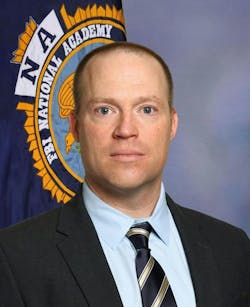Strategizing Partnerships in Public Safety
By Charles M. Russo, Ph.D., IFPC; Michael Whittington, Ph.D., Columbia Southern University
Public safety involves a collaborative effort from various sectors including law enforcement, emergency medical services (EMS), fire professionals and emergency management departments. Somewhat new to the effort are victim advocacy groups and non-governmental organizations (NGOs). Both governmental and non-governmental organization victim advocacy groups are a growing, critical element to public safety.
Establishing strong partnerships between these sectors allows public safety to create a more systematic approach to victim advocacy and investigative support (PowerDMS, 2020; San Francisco District Attorney, n.d.). To promote this “victim-centered” approach, public safety agencies can implement strategies to foster interagency collaboration within public safety sectors, including victim advocacy groups and community organizations. These strategies encompass the development of coordinated response protocols, shared training, joint outreach, and resource sharing.
Responsibilities of victim advocates
Victim advocates, sometimes called victim specialists, support and assist survivors of violent or exploitative crimes (Patterson & Campbell, 2010). In government-operated victim assistance centers, advocates provide survivors with emotional support and help navigate the legal system. They connect survivors with available resources and facilitate communication for court appearances. For juvenile victims, victim advocates specialize in conducting forensic child interviews. They also possess proficiency to interview effectively, utilizing methods designed to suit the children's level of development (Powell et al., 2017).
In non-government organizational victim advocacy groups, advocates provide crisis intervention, assess the unique requirements of survivors, and educate them on their rights and available options. They also help victims devise safety plans and empower them to achieve self-sufficiency. NGOs have different funding sources, allowing greater flexibility in service offerings than the public sector.
Throughout the United States, government-operated victim advocacy units, also known as victim services units, have gained momentum. There are now victim service units in major cities such as Austin, Denver, Los Angeles, Phoenix, San Francisco and San Jose, California. As an example of a successful government-managed program, the Seattle Human Services, under the Community Safety and Victim Support, has a Crime Survivor Services Unit (CSS) embedded within the Seattle Police Department. CSS offers victim advocates who provide critical incident response to victims and their families. They also assist in referring individuals to community resources and facilitate seeking restitution for victims. (Seattle.gov, 2023; Denver District Attorney, 2023)
Other jurisdictions combine advocacy services through collaboration with NGOs for greater victim care. For example, in San Jose, the Victim Services Unit of the Santa Clara County District Attorney’s Office offers “a voice in the criminal justice process,” including financial support and referral services. The organization provides aid with protective orders, compensation claims, and regular updates regarding the investigation and prosecution procedures (Santa Clara County District Attorney, 2023). In the same location, an NGO called “Community Solutions for Children Families and Individuals,” serves victims of violence by providing them “a comprehensive spectrum of prevention, intervention, treatment, and residential services.” (Communitysolutions.org, 2023) The government-operated and the NGO collaborate openly and set priorities for victim services.
The role of a victim advocate in a public safety department typically involves providing prompt and ongoing assistance to victims. Their duties may differ based on the needs of the public safety agency and the locality for which they are responsible. A victim advocate in a non-governmental agency differs in victim protection (e.g., no legal powers). Still, it offers victims a different source of assistance should they fear government interaction. Victims may shy away from government services for several reasons, such as legal residency issues, personal criminal history, previous poor service experiences and/or fear. (Ballucci & Stathakis, 2022; Young et al., 2022)
Victim advocates: An investigative multiplier
A victim advocate’s main objective is to ensure the welfare and empowerment of the victims throughout the legal proceedings and subsequent stages.
Implementing this collaborative approach guarantees efficient coordination and facilitates the exchange of information among all relevant stakeholders (public and private). Here are some of the key responsibilities and activities of victim advocates cases:
Victim advocates offer crisis intervention services to individuals who have experienced urgent and distressing situations. The organization provides prompt assistance through emotional support, developing safety plans, and facilitating access to vital services such as shelter, medical care, and legal aid. With a focus on early identification and referral, the advocate frequently collaborates closely with law enforcement and various service providers, such as social services, rehabilitation centers, counseling agencies, and medical facilities.
Providers may consist of NGOs in addition to public services. The primary objective is to identify potential victims of crime (assault, rape, human trafficking, etc.) and ensure their timely referral to the appropriate support services. Furthermore, advocates can accompany law enforcement officials during rescue operations or actively engage in victim-centered investigations. (Pajón & Walsh, 2022; Gibbs et al., 2015)
Advocates play a vital role in facilitating the connection between survivors and a wide range of resources and providing support for long-term recovery and reintegration, including medical and mental health services, housing assistance, educational opportunities, employment support, and immigration aid. This involves referral and resource coordination to ensure survivors have access to the necessary support. The organization collaborates with community organizations and service providers to ensure survivors receive support.
Advocates collaborate with survivors to develop personalized safety plans based on their circumstances. The mentioned plans include protection, relocation, securing restraining orders, and aiding in obtaining visas or immigration relief. These strategies are specifically designed to support individuals who have experienced trafficking.
Victim advocate organizations engage in policy-related endeavors, including raising public awareness about human trafficking, advocating for legislation and policies, and collaborating with governmental agencies and other non-governmental organizations. It is crucial to acknowledge that victim advocates collaborate with law enforcement agencies, prosecutors, social service providers, and other professionals in the fight to support victims of crime. This collaboration aims to establish a well-coordinated and victim-focused response. (Ballucci & Stathakis, 2022)
Law enforcement and victim advocacy
Law enforcement agencies serve as the first line of contact for victims of crime, making them essential in victim advocacy. However, officers' roles are often limited to crime-solving, leaving victim support to specialized advocates (Dugan & Apel, 2003). Their primary role also confines them to maintaining law and order, leaving a gap in providing victim support, which could open channels of communication that could help the officers’ investigations. To do so, advocates can work closely with law enforcement, and serve as a bridge between victims and the criminal justice system. (Farrell & Pfeffer, 2014)
An example of this is from the San Francisco Police Department, which has a dedicated division called the Victims Services Division (2023). The division collaborates with law enforcement officers to implement a comprehensive strategy for victim support. (San Francisco Police Department, 2021) Officers prioritize the investigation and resolution of criminal incidents. In another example, the New York City Police Department (NYPD) provides a comprehensive victim's assistance program that services needy individuals. These services include professional counseling, advocacy with other relevant agencies, and support in obtaining orders of protection (New York City Police Department, 2020). Advocates collaborate closely with law enforcement officers directly engaged in criminal investigations.
These examples show that establishing a strong rapport between the victim and the investigator can yield benefits such as more comprehensive victim statements, augmenting the investigation's quality and possibly prosecutions. (Ballucci & Stathakis, 2022; Pajón & Walsh, 2022; Gibbs et al., 2015)
Interagency collaboration in public safety
The advantages of collaboration between these sectors have been well documented in studies and implementations. For instance, in a 2019 report, which presented evidence that the integration of law enforcement and EMS efforts could lead to improved victim assistance (Willing, 2020). This collaboration between law enforcement and EMS addressed the criminal aspects of an emergency while ensuring that victims received prompt medical attention from EMS professionals. Previous research has demonstrated that these enhancements positively impact the survival rates of victims, particularly in fire-related incidents (Bureau of Justice Statistics. 2019).
Another illustration is in the community paramedicine program in San Diego, California. This program entails the collaboration of EMS providers with law enforcement and social service agencies to deliver a more comprehensive level of care for patients. In addition to attending to patients' immediate medical requirements, the program also emphasizes facilitating their access to long-term support resources, such as addiction services or housing assistance (San Diego County EMS Office, 2022). Implementing this approach to patient care guarantees the prompt fulfillment of victims' immediate needs. It also tackles the underlying factors that may impact their safety and overall well-being.
These examples present evidence of the potential advantages of interagency collaboration in public safety. By working together, these agencies can offer more comprehensive and effective emergency response, ultimately enhancing victim advocacy and improving public safety.
Law enforcement plays a vital role in public safety and resolving criminal cases such as human trafficking, however, it is important to recognize the significant impact of victim advocates. They offer essential services to individuals impacted by crime and facilitate communication between law enforcement and victims, improving public safety outcomes.
Critical strategies
Training and Education: Implementing comprehensive training programs can facilitate the development of a collective understanding and foster mutual respect among professionals in public safety. One potential approach to accomplish this objective is incorporating victim advocacy into law enforcement training programs, fostering empathy, enhancing communication skills, and upholding victims' rights (Bureau of Justice Statistics, 2019). The incorporation of victim advocacy into law enforcement training programs has the potential to improve how law enforcement personnel engage with victims significantly. The International Association of Chiefs of Police (IACP) has developed specialized training modules to improve officers' comprehension of victimology, victim's rights, trauma-informed responses, and communication skills. (IACP, 2020)
Development of Coordinated Response Protocols: Establishing coordinated response protocols can enhance interagency cooperation. These protocols offer a systematic approach to managing incidents and ensuring the needs of victims are addressed. A protocol was implemented in San Diego in 2021, established a collaboration between the Police Department and EMS (San Diego Police Department, 2022). This initiative led to a 12% enhancement in the overall response time, as reported by the San Diego County EMS Office (2022). The protocol defined roles and responsibilities for both agencies, resulting in a streamlined process and reduced likelihood of delays or conflicts.
Utilization of Shared Resources: The utilization of shared resources, such as data, expertise, and equipment, has the potential to enhance operational efficiency significantly. An example is the implementation of shared databases, such as the National Incident-Based Reporting System (NIBRS). The system enhances information sharing among law enforcement agencies. Promoting a well-informed and coordinated response to criminal activities contributes to the effectiveness of law enforcement efforts (FBI, 2021).
Non-Government Partner Outreach: Combining law enforcement with victim advocates can be a force multiplier in outreach opportunities. The hospitality industry can be a location to save trafficking victims. Law enforcement with victim advocate partners can provide outreach to hotels within a specified area known for trafficking (often called the “blade”). This outreach can be done through fliers, bathroom posters, and keycard sleeve literature. Hotel staff can be trained on the visual and behavior identifiers of human trafficking victims. In addition to outreach, hoteliers can provide other resources for staged hotel operations for victim recovery. This can be done through partnerships with hotels that provide free rooms to task forces that set up "outcall" style dates with female trafficking victims.
Using non-profit victim advocacy groups is also in law enforcement's best interests. Although some agencies have embedded victim advocacy groups, these groups have limited budgets and may be constrained by governmental policy. Non-governmental, non-profit victim groups may provide additional services to victims. For example, a local Christian charity group that provides care kits for recently rescued victims.
Case study: The Oklahoma City Model
The Oklahoma City Model provides a prime example of effective interagency collaboration. Law enforcement, fire, EMS, and emergency management agencies partner with local victim advocacy organizations. Since its inception in 2017, this model has seen a 20% increase in successful victim support outcomes (Oklahoma City Police Department, 2020).
The Oklahoma City Model epitomizes successful interagency collaboration. It combines the expertise of law enforcement, fire, EMS, and emergency management agencies with the specialized skills of local victim advocacy organizations. The model's effectiveness is evidenced by a 20% increase in successful victim support outcomes since its implementation in 2017 (Oklahoma City Police Department, 2020).
Implementing strategies such as comprehensive training and education, the establishment of coordinated response protocols, and the practice of resource sharing can significantly enhance the efficiency and effectiveness of public safety agencies. This, in turn, can lead to improved victim advocacy and better outcomes for public safety.
In conclusion
To improve the efficacy of victim advocacy, public safety sectors must establish and foster robust partnerships. By implementing collaborative training, coordinated protocols, and shared resources, agencies can deliver comprehensive and compassionate support to victims.
It is crucial to emphasize the significance of cultivating strong partnerships among law enforcement agencies and multiple public safety entities: EMS, fire departments, emergency management agencies, and victim advocacy organizations.
Notable collaborations include the successful integration of law enforcement and EMS in prominent cities across the nation and the joint initiatives by police departments and other public safety entities (Willing, 2020). These efforts have enhanced victim assistance services and expedited emergency response times.
Although law enforcement officers are typically the initial point of contact for victims, their primary responsibilities often restrict their ability to offer extensive support. This is where specialized victim advocates play a crucial role. Advocates facilitate communication and collaboration between victims and the criminal justice system.
These partnerships can be improved by implementing strategies such as thorough training and education, synchronized response protocols, and the sharing of resources. By adopting these strategies and cultivating successful partnerships, public safety officials could enhance operational efficiency and effectiveness and substantially improve victim advocacy and overall public safety outcomes.
About the Authors
Charles M. Russo, Ph.D., is a professor at Columbia Southern University, American Military University, and St. John’s University. He is a veteran U.S. Navy Intelligence Specialist, a former intelligence analyst of the FBI, and he has more than 30 years of experience in intelligence and counterterrorism analysis. The former associate dean of Intelligence Management for National American University’s Henley-Putnam School of Strategic Security.
Michael Whittington, Ph.D., is a 17-year law enforcement professional. He currently serves in a supervisory position in a law enforcement agency in California and as an adjunct professor in criminal justice at Columbia Southern University. He holds an MBA from San Jose State University and is a doctorate in criminal justice and homeland security from Liberty University.
About Columbia Southern University
As an innovator in online education, CSU was established in 1993 to provide an alternative to the traditional university experience. CSU offers online associate, bachelor’s, master’s and doctoral degrees such as business administration, criminal justice, fire administration and occupational safety and health. Visit ColumbiaSouthern.edu or call (877) 347-6050 to learn more.
References
Ballucci, D., & Stathakis, F. (2022). Re-conceptualizing success: Investigating specialized units responses to the sexual trafficking of female victim-survivors. Feminist Criminology, 17(5), 661–683. https://doi.org/10.1177/15570851221114396
Bureau of Justice Statistics. (2019). National Survey of Victim Service Providers. Inter-university Consortium for Political and Social Research. https://doi.org/10.3886/ICPSR38149.v1
Community Solutions. (2023). Community Solutions. https://www.communitysolutions.org/
Denver District Attorney. (2023). Victim Assistance. https://www.denverda.org/victim-assistance/
Dugan, L., & Apel, R. (2003). An Exploratory Study of the Violent Victimization of Women: Situational Context. Criminology, 41(3), 959–979. https://doi-org.libraryresources.columbiasouthern.edu/10.1111/j.1745-9125.2003.tb01010.x.
FARRELL, A., & PFEFFER, R. (2014). Policing human trafficking: Cultural blinders and organizational barriers. The Annals of the American Academy of Political and Social Science, 653(1), 46-64. https://doi.org/10.1177/0002716213515835
FBI. (2021). National Incident-Based Reporting System (NIBRS). Federal Bureau of Investigation. https://www.fbi.gov/how-we-can-help-you/more-fbi-services-and-information/ucr/nibrs
Gibbs, D. A., Hardison Walters, J. L., Lutnick, A., Miller, S., & Kluckman, M. (2015). Services to domestic minor victims of sex trafficking: Opportunities for engagement and support. Children and Youth Services Review, 54, 1–7. https://doi.org/10.1016/j.childyouth.2015.04.003
IACP. (2020). Enhancing law enforcement response to victims strategy. International Association of Chiefs of Police. https://www.theiacp.org/enhancing-law-enforcement-response-to-victims-downloadable-resources
New York City Police Department. (2020). Victim's Assistance Program. New York City Police Department. https://www.nyc.gov/site/nypd/services/victim-services/cvap.page
Oklahoma City Police Department. (2020). Annual report. Oklahoma City Police Department. Retrieved from https://www.okc.gov/home/showpublisheddocument/29010
Pajón, L., & Walsh, D. (2022). The importance of multi-agency collaborations during human trafficking criminal investigations. Policing & Society, 33(3), 296-314. https://doi.org/10.1080/10439463.2022.2106984
Patterson, D., & Campbell, R. (2010). Why rape survivors participate in the criminal justice system. Journal of Community Psychology, 38(2), 191–205. https://doi.org/10.1002/jcop.20359
Powell, M. B., Burrows, K. S., Brubacher, S. P., & Roberts, K. P. (2017). Prosecutors’ Perceptions on Questioning Children about Repeated Abuse. Psychiatry, Psychology & Law, 24(1), 74–89. https://doi.org/10.1080/13218719.2017.1273749
San Diego County EMS Office. (2022). Community paramedicine and Triage to Alternate Destination. San Diego County. https://www.sandiegocounty.gov/content/sdc/ems/Community_Paramedicine.html
San Diego Police Department. (2022). Annual report. San Diego Police Department. https://www.sdsheriff.gov/home/showpublisheddocument/6601/638192172850100000
San Francisco District Attorney. (n.d.). Victim Services Division. https://sfdistrictattorney.org/victim-services/
Santa Clara County District Attorney. (2023). Victim Services Unit. https://countyda.sccgov.org/victim-services/victim-services-unit
Seattle.gov (2023). Human Services. https://www.seattle.gov/human-services/services-and-programs/safety-and-victim-support/crime-survivor-services
Young MT, Payan DD, Guzman-Ruiz IY. (2022). The structural impacts of enforcement policy on Latino immigrant health. Front Public Health. https://www.doi.com/10.3389/fpubh.2022.928435


